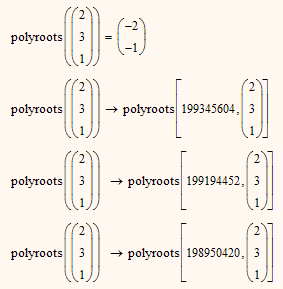Community Tip - New to the community? Learn how to post a question and get help from PTC and industry experts! X
- Subscribe to RSS Feed
- Mark Topic as New
- Mark Topic as Read
- Float this Topic for Current User
- Bookmark
- Subscribe
- Mute
- Printer Friendly Page
polyroots with two arguments
- Mark as New
- Bookmark
- Subscribe
- Mute
- Subscribe to RSS Feed
- Permalink
- Notify Moderator
polyroots with two arguments
Hello everybody !
I am just curious if the first argument of polyroots has some (useful) meaning (see highlighted region in attached), since subsequent calculations in the worksheet work fine.
The equation originates from the simple DE : dT(z)/dz = [deltaH/cpm(T)] * dgCO(z)/dz , with the initial conditions : T(0) = T0 and gCO(0) = some value.
I suppose that's something coming from the cuisine of muPad symbolic engine...
Note that value displayed as first argument at polyroots may change on re-opening the file.
Best regards, Liv.
Solved! Go to Solution.
- Labels:
-
Other
Accepted Solutions
- Mark as New
- Bookmark
- Subscribe
- Mute
- Subscribe to RSS Feed
- Permalink
- Notify Moderator
Interesting!
The first parameter which is added by symbolic evaluation changes also when the expression is evaluated several times but it does no change when the sheet or expression is recalculated.

Basically polyroots is a function which should only be evaluated numerically.
I have no idea what the symbolics thinks it is.
Even in Mupad its a numerical function only and the syntax is different from the one used in Mathcad
-> Numerical roots of a univariate polynomial - MuPAD - MathWorks Deutschland
The expression produced by the symbolic eval cannot be evaluated numerically and the error message is remarkable

As far as I am aware accepts polyroot only 1 argument (the coeff vector), not 2, and as far as I see in the picture its applied to just 2 arguments and not to 4.
- Mark as New
- Bookmark
- Subscribe
- Mute
- Subscribe to RSS Feed
- Permalink
- Notify Moderator
Interesting!
The first parameter which is added by symbolic evaluation changes also when the expression is evaluated several times but it does no change when the sheet or expression is recalculated.

Basically polyroots is a function which should only be evaluated numerically.
I have no idea what the symbolics thinks it is.
Even in Mupad its a numerical function only and the syntax is different from the one used in Mathcad
-> Numerical roots of a univariate polynomial - MuPAD - MathWorks Deutschland
The expression produced by the symbolic eval cannot be evaluated numerically and the error message is remarkable

As far as I am aware accepts polyroot only 1 argument (the coeff vector), not 2, and as far as I see in the picture its applied to just 2 arguments and not to 4.
- Mark as New
- Bookmark
- Subscribe
- Mute
- Subscribe to RSS Feed
- Permalink
- Notify Moderator
"remarkable" : agree...
One can get also something like :

- Mark as New
- Bookmark
- Subscribe
- Mute
- Subscribe to RSS Feed
- Permalink
- Notify Moderator
Strange!
"solvecb" seems to be an internal command. I don't know any CAS this command could stem from.
It looks like it has nothing to do with the symbolics. Its implemented in mathdllr.dll and is referenced in mpl\mcdtranslator.mpl and also in prolog\compute.prolog.
- Mark as New
- Bookmark
- Subscribe
- Mute
- Subscribe to RSS Feed
- Permalink
- Notify Moderator
Anyway... it works (fortunately) with symbolics and proved useful since it was able to quickly provide all the roots.
Is the behavior the same in Prime 3.1 ? (don't have it yet)
Thank you a lot (again) Werner for your time & for documenting my curiosity,
Liv.
- Mark as New
- Bookmark
- Subscribe
- Mute
- Subscribe to RSS Feed
- Permalink
- Notify Moderator
> Anyway... it works (fortunately) with symbolics and ...
You mean it works with numerics. The symbolic result is rather useless, I guess.
> Is the behavior the same in Prime 3.1 ?
Have Prime 3.0 here installed and the behavior is not the same, its more consistent here. As "polyroots" is a numerics-only function, the symbolic evaluation simply returns the very same expression.
And also the error message of the numerics is more meaningful (it moans about the first argument not being a vector).

Whats still a little bit strange in Prime is the fact, that the numerics still thinks that the function can accept two arguments (the help/documentation only describes the use with one vector argument). It seems that a second argument is simply ignored as long as the first one is a vector and more than 2 arguments throw an error.

- Mark as New
- Bookmark
- Subscribe
- Mute
- Subscribe to RSS Feed
- Permalink
- Notify Moderator
Werner Exinger wrote:
Strange!
"solvecb" seems to be an internal command. I don't know any CAS this command could stem from.
"solvecb" - "solve" callback?
- Mark as New
- Bookmark
- Subscribe
- Mute
- Subscribe to RSS Feed
- Permalink
- Notify Moderator
callback??
We can't know and I never came across a command with that name in any math program I used.





